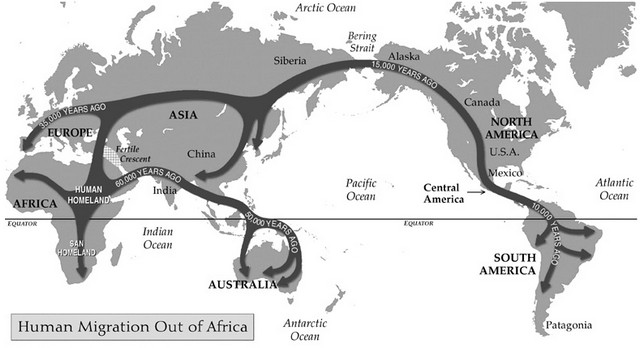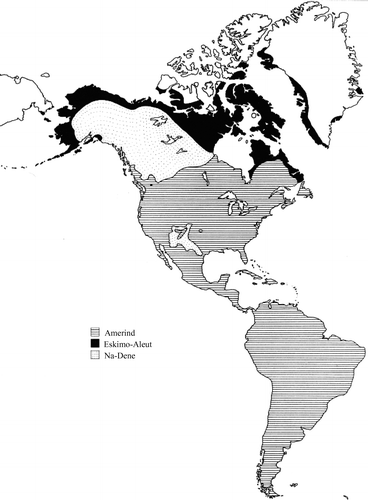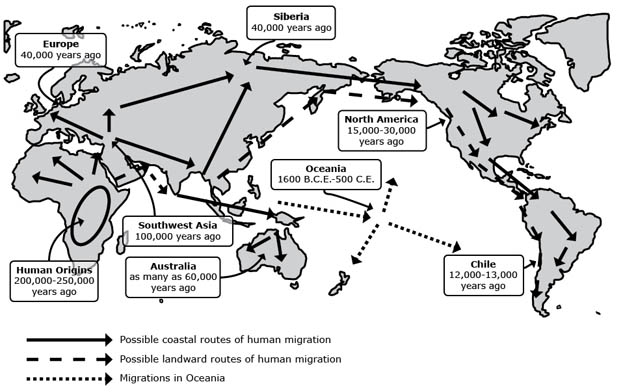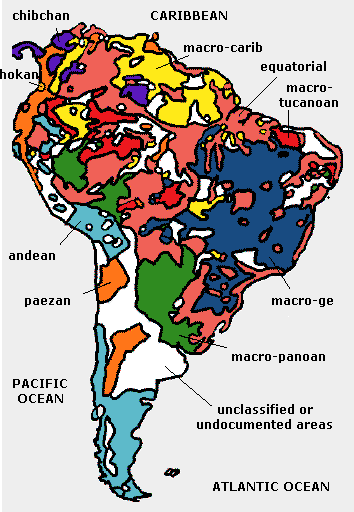DNA Confirms that First North & South Americans Came From Siberia
posted on August 20th, 2012 in Linguistics, Recent Discoveries

Humans (Homo sapiens) ventured out of Africa Some 65,000 years ago. They finally arrived in South America some 14,000 years ago
Earliest Americans Arrived in Waves, DNA Study Finds
July 11, 2012
NYT
North and South America were first populated by three waves of migrants from Siberia rather than just a single migration, say researchers who have studied the whole genomes of Native Americans in South America and Canada.
Some scientists assert that the Americas were peopled in one large migration from Siberia that happened about 15,000 years ago, but the new genetic research shows that this central episode was followed by at least two smaller migrations from Siberia, one by people who became the ancestors of today’s Eskimos and Aleutians and another by people speaking Na-Dene, whose descendants are confined to North America. The research was published online on Wednesday in the journal Nature.
The finding vindicates a proposal first made on linguistic grounds by Joseph Greenberg, the great classifier of the world’s languages. He asserted in 1987 that most languages spoken in North and South America were derived from the single mother tongue of the first settlers from Siberia, which he called Amerind. Two later waves, he surmised, brought speakers of Eskimo-Aleut and of Na-Dene, the language family spoken by the Apache and Navajo.

Joseph Greenberg’s Linguistic Map of the Americas Seems to Have Been Confirmed by Recent Genetic Research
But many linguists who specialize in American languages derided Dr. Greenberg’s proposal, saying they saw no evidence for any single ancestral language like Amerind. “American linguists made up their minds 25 years ago that they wouldn’t support Greenberg, and they haven’t changed their mind one whit,” said Merritt Ruhlen, a colleague of Dr. Greenberg, who died in 2001.
The new DNA study is based on gene chips that sample the entire genome and presents a fuller picture than earlier studies, which were based on small regions of the genome like the Y chromosome or mitochondrial DNA. Several of the mitochondrial DNA studies had pointed to a single migration.
A team led by David Reich of Harvard Medical School and Dr. Andres Ruiz-Linares of University College London reported that there was a main migration that populated the entire Americas. They cannot date the migration from their genomic data but accept the estimate by others that the migration occurred around 15,000 years ago. This was in the window of time that occurred after the melting of great glaciers that blocked passage from Siberia to Alaska, and before the rising waters at the end of the last ice age submerged Beringia, the land bridge between them.
They also find evidence for two further waves of migration, one among Na-Dene speakers and the other among Eskimo-Aleut, again as Dr. Greenberg predicted. But whereas Dr. Greenberg’s proposal suggested that three discrete groups of people were packed into the Americas, the new genome study finds that the second and third waves mixed in with the first. Eskimos inherit about half of their DNA from the people of the first migration and half from a second migration. The Chipewyans of Canada, who speak a Na-Dene language, have 90 percent of their genes from the first migration and some 10 percent from a third.
It is not clear why the Chipewyans and others speak a Na-Dene language if most of their DNA is from Amerind speakers. Dr. Ruiz-Linares said a minority language could often dominate others in the case of conquest; an example of this is the ubiquity of Spanish in Latin America.
If the genetics of the early migrations to the Americas can be defined well enough, it should in principle be possible to match them with their source populations in Asia. Dr. Greenberg had argued on linguistic grounds that the Na-Dene language family was derived from Ket, spoken by the Ket people in the Yenisei valley of Siberia. But Dr. Reich said there was not yet enough genomic data from Asia or the Americas to make these links. His samples of Na-Dene and Ket DNA did not match, but the few Ket samples he had may have become mixed with DNA from people of other ethnicities, so the test, in his view, was inconclusive.
The team’s samples of Native American genomes were drawn mostly from South America, with a handful from Canada. Samples from tribes in the United States could not be used because the existing ones had been collected for medical reasons and the donors had not given consent for population genetics studies, Dr. Ruiz-Linares said. Native Americans in the United States have been reluctant to participate in inquiries into their origins. The Genographic Project of the National Geographic Society wrote recently to all federally recognized tribes in the United States asking for samples, but only two agreed to give them, said Spencer Wells, the project director.
Interracial marriage — or admixture, as geneticists call it — may have distorted earlier efforts to trace ancestry because subjects assumed to be American may have had European or other DNA admixed in their genomes. Dr. Reich and his colleagues have developed a method to define the racial origin of each segment of DNA and have found that on average 8.5 percent of Native American DNA belongs to other races. They then screened these admixed sections out of their analysis.
Archaeologists who study Native American history are glad to have the genetic data but also have reservations, given that several of the geneticists’ conclusions have changed over time. “This is a really important step forward but not the last word,” said David Meltzer of Southern Methodist University, noting that many migrations may not yet have shown up in the genetic samples. Michael H. Crawford, an anthropologist at the University of Kansas, said the paucity of samples from North America and from coastal regions made it hard to claim a complete picture of early migrations has been attained.
“Sometimes the statisticians make wonderful interpretations, but you have to be very guarded,” he said.
The geneticists’ finding of a single main migration of people who presumably spoke a single language at the time confirms Dr. Greenberg’s central idea that most American languages are descended from a single root, even though the genetic data cannot confirm the specific language relationships he described.
“Many linguists put down Greenberg as rubbish and don’t believe his publications,” Dr. Ruiz-Linares said. But he considers his study a substantial vindication of Dr. Greenberg. “It’s striking that we have this correspondence between the genetics and the linguistics,” he said.


